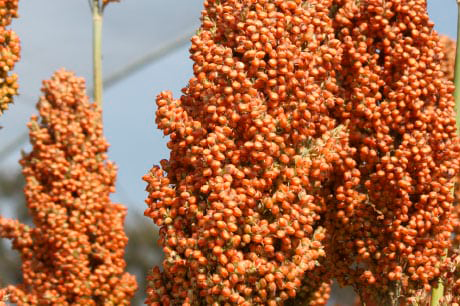Genetic improvement of sorghum at INIFAP
DOI:
https://doi.org/10.29312/remexca.v12i25.2824Keywords:
seeds, tolerance, varietiesAbstract
In Mexico, genetic improvement of sorghum began in 1944 at the Office of Special Studies. Later, improvement activities were carried out in three regions with the introduction of genetic material from which lines were derived and the first adapted sorghum hybrids were generated. The program has focused on the generation of genetic material for several niche markets including balanced food, food for human consumption and biofuel production. Among the genetic materials, the hybrid RB-3030 stands out for having been the one with the highest production by PRONASE at the time. To date, 36 hybrids and varieties have been generated, of which 12 are currently being used, among which the red-orange bean sorghums RB-Norteño and RB-Huasteco and the white sorghum variety RB-Paloma stand out. As well, the forage sorghum Sinaloense 202 and Gavatero-203 stand out. On the other hand, the sorghum RB-Cañero, RB Cañaveral, RB Tehua and RB-Pirulí have been formed for bioethanol production. In addition, there are parental lines of hybrids that are acquired by companies for the production of certified seed. There are several challenges such as increasing production, but in the short term it is necessary to increase the promotion and marketing of genetic materials, and in the medium term to strengthen research in disease control, tolerance of draughts and salts, and obtain varieties with better nutritional and energy quality.
Downloads
References
Betancourt-Vallejo, A. 1975. Resumen de los trabajos de maíz y sorgo del CIAT. In: II Reunión Nacional de Investigadores de maíz y sorgo. INIA. 26-27 de julio. Cotaxtla, Veracruz. 104 p.
Cisneros, L. M. E.; Montes, G. N.; Aguilar, U. M. G.; Uribe, G. S. y Rebolledo, G. R. L. 2018. Sorgos dulces para la producción de biomasa y azúcares: RB-Piruli, RB Cañaveral y RB Tehua. INIFAP-CIRNE-CERIB. Folleto técnico núm. 71. 49 p.
Montes, G. N.; Williams, A. H.; Pecina, Q. V.; Arcos, C. G.; Vargas, V. E.; Espinosa, R. M. y Herrera, C. C. 2013a. RB-Norteño: Sorgo granífero para las áreas de temporal de Tamaulipas y Guanajuato. SAGARPA-INIFAP-CIRNE-CERIB. Folleto técnico núm. 55. 32 p.
Montes, G. N.; Williams, A. H.; Arcos, C. G.; Pecina, Q. V.; De la Garza, C. M.; Cisneros, L. M. E.; Vargas, V. E. y Herrera, C. C. 2013b. RB-Huasteco: sorgo de grano para elevar la sustentabilidad de las áreas de riego y buen temporal de Tamaulipas y Guanajuato. SAGARPA-INIFAP-CIRNE-CERIB. Folleto técnico núm. 52. 35 p.
Rodríguez, H. R. y Torres, M. H. 1992. Esterilización génico-citoplásmica de una línea restauradora de sorgo. I. Segregación y efecto ambiental en el sistema Milo- Kafir (A1). In: III Congreso Nacional de la Sociedad Mexicana de Genética. Mazátlan, Sinaloa. 212-213 pp.
Rodríguez, H. R.; Williams, A. H.; Torres, M. H. y Montes, G. N. 1994. Introducción de androesterilidad a una línea restauradora de sorgo. III. Segregación de generaciones avanzadas. In: Memoria XV Congreso Nacional de Fitogenética. 25-30 de septiembre. FAUANL. Marín, Nuevo León. 497 p.
Williams-Alanis, H. y Betancourt-Vallejo, A. 1979. Mejoramiento del sorgo para grano en la región norte de Tamaulipas mediante híbridos provenientes del cruzamiento de líneas A y R mexicanas (INIA) por introducidas, EUA. In: X Reunión de la Asociación Latinoamericana de Ciencias Agrícolas. 22 al 28 de abril. Acapulco, Guerrero. 72 p.
Williams-Alanís, H.; Rodríguez-Herrera, R. y Montes-García, N. 1995. 20 años de investigación en sorgo en el Campo Experimental Río Bravo. Germen-Boletín de Intercambio Técnico y Científico de la Sociedad Mexicana de Fitogenética. 11:1-35.

Downloads
Published
How to Cite
Issue
Section
License
Copyright (c) 2021 Revista Mexicana de Ciencias Agrícolas

This work is licensed under a Creative Commons Attribution-NonCommercial 4.0 International License.
The authors who publish in Revista Mexicana de Ciencias Agrícolas accept the following conditions:
In accordance with copyright laws, Revista Mexicana de Ciencias Agrícolas recognizes and respects the authors’ moral right and ownership of property rights which will be transferred to the journal for dissemination in open access. Invariably, all the authors have to sign a letter of transfer of property rights and of originality of the article to Instituto Nacional de Investigaciones Forestales, Agrícolas y Pecuarias (INIFAP) [National Institute of Forestry, Agricultural and Livestock Research]. The author(s) must pay a fee for the reception of articles before proceeding to editorial review.
All the texts published by Revista Mexicana de Ciencias Agrícolas —with no exception— are distributed under a Creative Commons License Attribution-NonCommercial 4.0 International (CC BY-NC 4.0), which allows third parties to use the publication as long as the work’s authorship and its first publication in this journal are mentioned.
The author(s) can enter into independent and additional contractual agreements for the nonexclusive distribution of the version of the article published in Revista Mexicana de Ciencias Agrícolas (for example include it into an institutional repository or publish it in a book) as long as it is clearly and explicitly indicated that the work was published for the first time in Revista Mexicana de Ciencias Agrícolas.
For all the above, the authors shall send the Letter-transfer of Property Rights for the first publication duly filled in and signed by the author(s). This form must be sent as a PDF file to: revista_atm@yahoo.com.mx; cienciasagricola@inifap.gob.mx; remexca2017@gmail.
This work is licensed under a Creative Commons Attribution-Noncommercial 4.0 International license.


